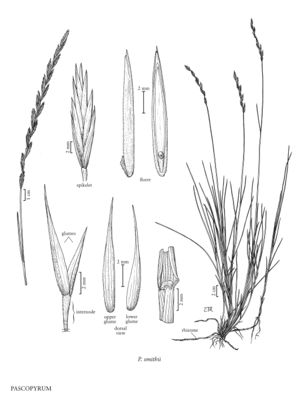Difference between revisions of "Pascopyrum smithii"
FNA>Volume Importer |
FNA>Volume Importer |
||
| Line 7: | Line 7: | ||
|synonyms={{Treatment/ID/Synonym | |synonyms={{Treatment/ID/Synonym | ||
|name=Elytrigia smithii | |name=Elytrigia smithii | ||
| − | |authority= | + | |authority= |
| + | |rank=species | ||
}} {{Treatment/ID/Synonym | }} {{Treatment/ID/Synonym | ||
|name=Elytrigia dasystachya | |name=Elytrigia dasystachya | ||
| − | |authority= | + | |authority= |
| + | |rank=species | ||
}} {{Treatment/ID/Synonym | }} {{Treatment/ID/Synonym | ||
|name=Elymus smithii | |name=Elymus smithii | ||
| − | |authority= | + | |authority= |
| + | |rank=species | ||
}} {{Treatment/ID/Synonym | }} {{Treatment/ID/Synonym | ||
|name=Agropyron spicatum var. molle | |name=Agropyron spicatum var. molle | ||
| − | |authority= | + | |authority= |
| + | |rank=variety | ||
}} {{Treatment/ID/Synonym | }} {{Treatment/ID/Synonym | ||
|name=Agropyron smithii var. palmeri | |name=Agropyron smithii var. palmeri | ||
| − | |authority= | + | |authority= |
| + | |rank=variety | ||
}} {{Treatment/ID/Synonym | }} {{Treatment/ID/Synonym | ||
|name=Agropyron smithii var. molle | |name=Agropyron smithii var. molle | ||
| − | |authority= | + | |authority= |
| + | |rank=variety | ||
}} {{Treatment/ID/Synonym | }} {{Treatment/ID/Synonym | ||
|name=Molle | |name=Molle | ||
| − | |authority= | + | |authority= |
| + | |rank=forma | ||
}} {{Treatment/ID/Synonym | }} {{Treatment/ID/Synonym | ||
|name=Agropyron smithii | |name=Agropyron smithii | ||
| − | |authority= | + | |authority= |
| + | |rank=species | ||
}} {{Treatment/ID/Synonym | }} {{Treatment/ID/Synonym | ||
|name=Agropyron elmeri | |name=Agropyron elmeri | ||
| − | |authority= | + | |authority= |
| + | |rank=species | ||
}} | }} | ||
|hierarchy=Poaceae;Poaceae subfam. Pooideae;Poaceae tribe Triticeae;Pascopyrum;Pascopyrum smithii | |hierarchy=Poaceae;Poaceae subfam. Pooideae;Poaceae tribe Triticeae;Pascopyrum;Pascopyrum smithii | ||
| Line 44: | Line 53: | ||
-->{{Treatment/Body | -->{{Treatment/Body | ||
|distribution=Wash.;Wis.;Wyo.;N.H.;N.Mex.;Tex.;Mass.;Tenn.;N.Y.;Calif.;Nev.;Colo.;Alaska;Kans.;N.Dak.;Nebr.;Okla.;Ark.;Ill.;Ga.;Ind.;Iowa;Ariz.;Idaho;Alta.;B.C.;Man.;Ont.;Que.;Sask.;Ohio;Utah;Mo.;Minn.;Mich.;Mont.;Ky.;Oreg.;S.Dak. | |distribution=Wash.;Wis.;Wyo.;N.H.;N.Mex.;Tex.;Mass.;Tenn.;N.Y.;Calif.;Nev.;Colo.;Alaska;Kans.;N.Dak.;Nebr.;Okla.;Ark.;Ill.;Ga.;Ind.;Iowa;Ariz.;Idaho;Alta.;B.C.;Man.;Ont.;Que.;Sask.;Ohio;Utah;Mo.;Minn.;Mich.;Mont.;Ky.;Oreg.;S.Dak. | ||
| − | |discussion=<p>Pascopyrum smithii is native to sagebrush deserts and mesic alkaline meadows, growing in both clay and sandy soils. Pascopyrum smithii is probably derived from a Leymus triticoides-Elymus lanceolatus cross (Dewey 1975); it is frequently confused with both. Leymus triticoides differs in usually having 2 spikelets per node and glumes that are narrower at the base. In E. lanceolatus, the leaves tend to be more evenly distributed and the glumes have straight midveins, become narrow beyond midlength, and tend to be wider at 3/4 length (0.35-1.6 mm). In addition, the first rachilla internodes of E. lanceolatus are often longer and narrower (the length/width ratio averaging 2.6, versus 1.8 in P. smithii). No infraspecific taxa of P. smithii are recognized here.</p> | + | |discussion=<p><i>Pascopyrum smithii</i> is native to sagebrush deserts and mesic alkaline meadows, growing in both clay and sandy soils. <i>Pascopyrum smithii</i> is probably derived from a <i>Leymus triticoides</i>-<i>Elymus lanceolatus</i> cross (Dewey 1975); it is frequently confused with both. <i>Leymus triticoides</i> differs in usually having 2 spikelets per node and glumes that are narrower at the base. In <i>E. lanceolatus</i>, the leaves tend to be more evenly distributed and the glumes have straight midveins, become narrow beyond midlength, and tend to be wider at 3/4 length (0.35-1.6 mm). In addition, the first rachilla internodes of <i>E. lanceolatus</i> are often longer and narrower (the length/width ratio averaging 2.6, versus 1.8 in <i>P. smithii</i>). No infraspecific taxa of <i>P. smithii</i> are recognized here.</p> |
|tables= | |tables= | ||
|references= | |references= | ||
| Line 53: | Line 62: | ||
-->{{#Taxon: | -->{{#Taxon: | ||
name=Pascopyrum smithii | name=Pascopyrum smithii | ||
| − | |||
|authority=(Rydb.) Barkworth & D.R. Dewey | |authority=(Rydb.) Barkworth & D.R. Dewey | ||
|rank=species | |rank=species | ||
| Line 61: | Line 69: | ||
|family=Poaceae | |family=Poaceae | ||
|illustrator=Cindy Roché | |illustrator=Cindy Roché | ||
| + | |illustration copyright=Utah State University | ||
|distribution=Wash.;Wis.;Wyo.;N.H.;N.Mex.;Tex.;Mass.;Tenn.;N.Y.;Calif.;Nev.;Colo.;Alaska;Kans.;N.Dak.;Nebr.;Okla.;Ark.;Ill.;Ga.;Ind.;Iowa;Ariz.;Idaho;Alta.;B.C.;Man.;Ont.;Que.;Sask.;Ohio;Utah;Mo.;Minn.;Mich.;Mont.;Ky.;Oreg.;S.Dak. | |distribution=Wash.;Wis.;Wyo.;N.H.;N.Mex.;Tex.;Mass.;Tenn.;N.Y.;Calif.;Nev.;Colo.;Alaska;Kans.;N.Dak.;Nebr.;Okla.;Ark.;Ill.;Ga.;Ind.;Iowa;Ariz.;Idaho;Alta.;B.C.;Man.;Ont.;Que.;Sask.;Ohio;Utah;Mo.;Minn.;Mich.;Mont.;Ky.;Oreg.;S.Dak. | ||
|reference=None | |reference=None | ||
| Line 66: | Line 75: | ||
|publication year= | |publication year= | ||
|special status= | |special status= | ||
| − | |source xml=https:// | + | |source xml=https://jpend@bitbucket.org/aafc-mbb/fna-data-curation.git/src/f50eec43f223ca0e34566be0b046453a0960e173/coarse_grained_fna_xml/V24/V24_1128.xml |
|subfamily=Poaceae subfam. Pooideae | |subfamily=Poaceae subfam. Pooideae | ||
|tribe=Poaceae tribe Triticeae | |tribe=Poaceae tribe Triticeae | ||
Revision as of 20:18, 16 December 2019
Culms 20-100 cm, glabrous. Auricles 0.2-1 mm, often purple; ligules about 0.1 mm; blades 2-26 cm long, 1-4.5 mm wide, decreasing in length upwards, spreading, rigid, adaxial surfaces with prominent veins. Spikes 5-17 cm; middle internodes 4.5-11 mm. Spikelets 12-26(30) mm, with 2-12 florets; lowest rachilla internodes in each spikelet 0.8-2 mm long, 0.5-0.9 mm wide at the top. Glumes 5-15 mm, lower glumes usually exceeded by the upper glumes; lower glumes 0.15-0.8 mm wide at 3/4 length; lemmas 6-14 mm, unawned or awned, awns 0.5-5 mm. 2n = 56.
Distribution
Wash., Wis., Wyo., N.H., N.Mex., Tex., Mass., Tenn., N.Y., Calif., Nev., Colo., Alaska, Kans., N.Dak., Nebr., Okla., Ark., Ill., Ga., Ind., Iowa, Ariz., Idaho, Alta., B.C., Man., Ont., Que., Sask., Ohio, Utah, Mo., Minn., Mich., Mont., Ky., Oreg., S.Dak.
Discussion
Pascopyrum smithii is native to sagebrush deserts and mesic alkaline meadows, growing in both clay and sandy soils. Pascopyrum smithii is probably derived from a Leymus triticoides-Elymus lanceolatus cross (Dewey 1975); it is frequently confused with both. Leymus triticoides differs in usually having 2 spikelets per node and glumes that are narrower at the base. In E. lanceolatus, the leaves tend to be more evenly distributed and the glumes have straight midveins, become narrow beyond midlength, and tend to be wider at 3/4 length (0.35-1.6 mm). In addition, the first rachilla internodes of E. lanceolatus are often longer and narrower (the length/width ratio averaging 2.6, versus 1.8 in P. smithii). No infraspecific taxa of P. smithii are recognized here.
Selected References
None.
